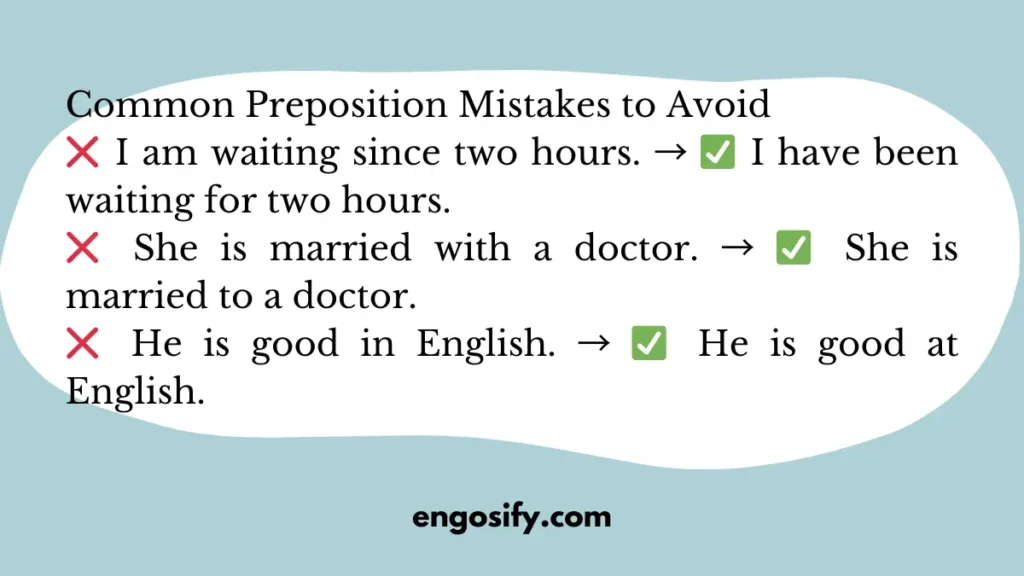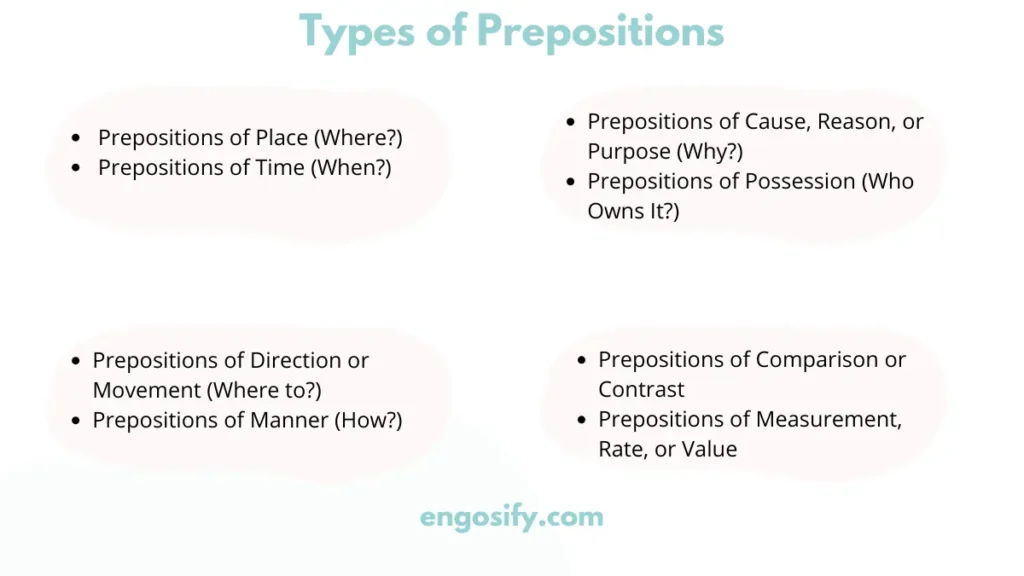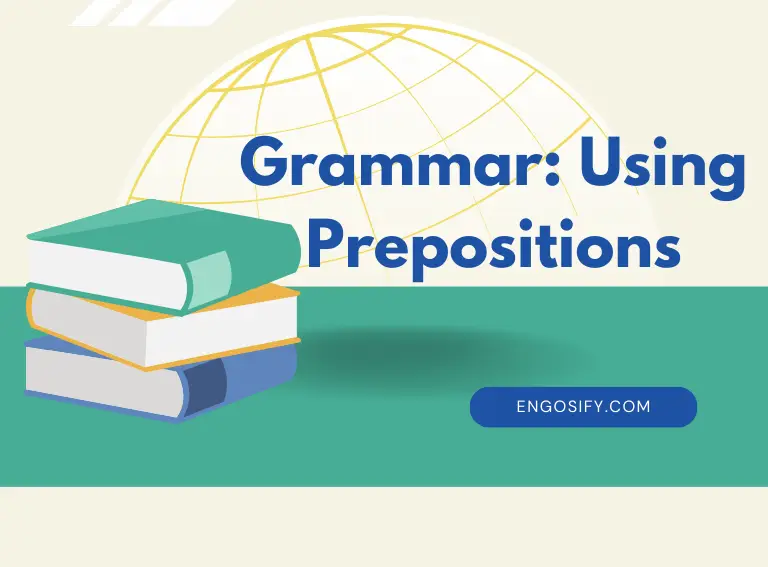Hey there, grammar enthusiasts! Diving into the world of prepositions might seem like navigating through a maze, but don’t worry – we’ve got your back! In this comprehensive guide, we’ll unravel the mysteries of these essential building blocks of English grammar, making them as clear as day.
Whether you’re a native speaker looking to polish your skills or an English learner trying to master these tricky little words, this guide will help you navigate the sometimes-confusing waters of prepositional usage. So, let’s roll up our sleeves and get started!
What are Prepositions?
Well, here’s the scoop: prepositions are those handy little words that help us connect different parts of a sentence, showing relationships between various elements. Think of them as the glue that holds our sentences together – pretty important stuff, right?
Understanding the Basics
You know what’s fascinating? According to the comprehensive guide to English grammar</a>, prepositions are among the most frequently used words in English. They’re like the unsung heroes of our language, working tirelessly behind the scenes to make our communication clear and precise.
These linguistic powerhouses serve three main functions:
- Connecting nouns to other parts of the sentence
- Showing relationships between different elements
- Adding essential context to our statements
Why Prepositions Matter
Let’s face it – without prepositions, we’d be lost in translation! Imagine trying to explain where you left your keys without using words like “on,” “in,” or “under.” Pretty challenging, huh? These little words make a world of difference in how we express ourselves.
Furthermore, mastering prepositions isn’t just about following grammar rules. It’s about enhancing your communication skills and expressing yourself with crystal-clear precision. After all, there’s a huge difference between being “in hot water” and “under water” – both literally and figuratively!
The Building Blocks of Clear Communication
Here’s something that might surprise you: English has roughly 150 prepositions, but we commonly use only about 50 of them in everyday communication. Talk about getting more bang for your buck! These versatile words help us:
- Express spatial relationships
- Indicate timing
- Show manner or method
- Establish connections between ideas
The beauty of prepositions lies in their versatility. They’re like the Swiss Army knives of grammar – small but incredibly useful tools that serve multiple purposes. And while they might seem simple at first glance, using them correctly can make the difference between sounding like a native speaker and struggling to get your point across.
Remember, mastering prepositions is a journey, not a destination. In the upcoming sections, we’ll dive deeper into different types of prepositions, explore their various uses, and tackle some common challenges that even native speakers face. Stay tuned!

Types of Prepositions
Simple Prepositions
Alright, let’s dive into the nitty-gritty of simple prepositions! These everyday MVPs of grammar might look basic, but they pack quite a punch in our daily communication. According to the preposition usage examples</a>, these are the most frequently used words in English conversations.
Think of simple prepositions as the bread and butter of prepositional phrases. They’re short, sweet, and straight to the point. Here’s what makes them tick:
Common Examples in Action:
- “The cat is in the box” (showing location)
- “Let’s meet at noon” (indicating time)
- “She’s walking by the river” (describing position)
- “This gift is for you” (expressing purpose)
But hold your horses – there’s more to these little words than meets the eye!
Complex Prepositions
Now, here’s where things get interesting! Complex prepositions are like the sophisticated cousins of simple prepositions. They’re combinations of words that work together to express more specific relationships.
Compound Prepositions
These bad boys are formed by joining two or more words:
- in front of (not just “in” or “front”)
- on top of (more specific than just “on”)
- next to (more precise than simply “by”)
Phrasal Prepositions
Talk about stepping up your grammar game! Phrasal prepositions are groups of words that function as a single prepositional unit:
- according to (when citing sources or references)
- apart from (showing exclusion)
- because of (indicating reason)
Pro tip: While using complex prepositions, remember that less is often more. Don’t get carried away trying to sound fancy – clarity is key!
When to Use What
Here’s the deal: choosing between simple and complex prepositions isn’t just about showing off your vocabulary. It’s about:
- Precision in meaning
- Natural flow of language
- Context appropriateness
For instance, saying “The book is on the table” is perfectly clear. But if you need to be more specific, you might say “The book is on top of the stack of papers.” See the difference?
Remember, using prepositions effectively is like adding seasoning to your cooking – you want just enough to enhance the flavor without overwhelming the dish. In the next section, we’ll explore how these different types of prepositions are used in specific contexts, focusing on place, time, and movement.

Preposition Usage
Prepositions of Place
Let’s get down to brass tacks with spatial prepositions! These location-savvy words help us map out our world with precision. The preposition practice exercises</a> show that mastering these can be quite the game-changer in your English journey.
Key Spatial Relationships:
- In (inside an enclosed space)
- On (touching a surface)
- At (specific point or location)
- Under (beneath something)
- Over (above without touching)
Here’s a fun fact: English speakers often visualize containers and surfaces differently than speakers of other languages. Mind-blowing, right?
Prepositions of Time
Oh boy, time-related prepositions can be trickier than a bag of monkeys! Let’s break them down:
The Big Three:
- At for specific times
- “Meet me at noon”
- “The show starts at 8 PM”
- On for days and dates
- “Born on Monday”
- “The meeting’s on July 4th”
- In for longer periods
- “In summer”
- “In the 21st century”
Prepositions of Movement
Now we’re cooking with gas! Movement prepositions add action and direction to our sentences. They’re like the GPS of grammar!
Dynamic Prepositions in Action:
- Through (passing from one side to another) “The train rushed through the tunnel”
- Across (moving from one side to the opposite) “Walking across the street”
- Along (following a path) “Strolling along the beach”
- Towards (in the direction of) “Running towards home”
Common Traps to Avoid
Listen up! Here are some head-scratchers that often trip people up:
- Mixing up in and into
- “She jumped in the pool” (already inside)
- “She jumped into the pool” (movement from outside)
- Confusing through and across
- “Walking through the forest” (amid trees)
- “Walking across the forest” (from one side to another)
Remember, using the right preposition is like hitting the bullseye – it takes practice, but when you get it right, it’s oh-so-satisfying! Practice makes perfect, and before you know it, these distinctions will become second nature.
Think of prepositions as the choreographers of language – they direct the dance between words, showing exactly how different parts of the sentence relate to each other. And just like in dance, timing and position are everything!
Common Challenges
Preposition Combinations
Well, well, well… if it isn’t the trickiest part of mastering prepositions! As noted in the comprehensive guide to English grammar</a>, these combinations can make your head spin faster than a carousel!
Verb + Preposition Patterns
Let’s crack this nut together! Here are some combinations that often leave learners scratching their heads:
- Depend on (not ‘of’ or ‘from’) “Success depends on hard work”
- Consist of (not ‘in’ or ‘by’) “The team consists of five players”
- Comply with (not ‘to’ or ‘for’) “You must comply with the rules”
Adjective + Preposition Combinations
Here’s where things get really interesting! These pairings are like dancing partners – they just work better together:
- Afraid of (not ‘from’) “She’s afraid of heights”
- Different from/to (regional variations) “Your answer is different from mine”
- Interested in (not ‘about’) “I’m interested in learning more”
Cultural Differences
Hold onto your hats, folks! This is where prepositions really show their true colors.
Cross-Language Confusion
Different languages have their own prepositional quirks. Check out these common mix-ups:
- Time Expressions
- English: “I’ll see you on Monday”
- Many languages: “I’ll see you in Monday”
- Transportation
- English: “In a car, on a bus”
- Other languages might use the same preposition for both
Common Interference Errors
Here’s the deal with language interference:
- Location Descriptions
- “At the corner” vs. “On the corner”
- “In the street” vs. “On the street”
- Time References
- “In time” (with enough time) vs.
- “On time” (punctual)
Pro Tips for Mastery:
- Think in chunks rather than individual words
- Practice with authentic materials
- Pay attention to native speaker usage
- Remember that context is king!
Look at prepositions as the seasoning in your linguistic cuisine – too little makes things bland, too much spoils the dish, but just the right amount? Pure perfection!
Remember, even native speakers sometimes wrestle with these combinations. It’s like learning to ride a bike – wobbly at first, but once you get the hang of it, you’ll be cruising along smoothly.
Advanced Topics
Stylistic Considerations
Alright, grammar aficionados, let’s level up! When it comes to prepositions, style can make or break your writing. According to the preposition usage examples</a>, understanding these nuances is crucial for effective communication.
Formal vs. Informal Usage
Here’s the scoop on how formality affects your prepositional choices:
Formal Context:
- “The meeting regarding the proposal…”
- “The results pursuant to the study…”
- “The decision with respect to your application…”
Informal Context:
- “The meeting about the proposal…”
- “The results from the study…”
- “The decision on your application…”
Writing Clarity and Preposition Placement
Let’s get real about placement! It’s not just about where you put your prepositions – it’s about how they flow:
- Strategic Placement
- Beginning: “In light of recent events…”
- Middle: “The impact of climate change on ecosystems…”
- End: “This is something I can’t put up with“
- Avoiding Preposition Overload
- Wordy: “The book of the student of the class of 2023″
- Better: “The 2023 student’s book”
Grammar Rules
Now, let’s bust some myths and establish some truths about prepositional grammar rules!
The Great Preposition Debate
You’ve probably heard the old rule about never ending a sentence with a preposition. Well, guess what? That’s a myth Winston Churchill supposedly debunked with his famous quip: “This is the sort of nonsense up with which I will not put!”
Modern Usage Guidelines:
- Ending with prepositions is perfectly acceptable when it sounds natural
- Forcing prepositions to the middle can make sentences sound stuffy
- Let clarity and natural flow guide your choices
Prepositions in Questions
Here’s how to handle prepositions in questions like a pro:
Formal:
- “For whom is this package intended?”
- “To what extent has the policy been effective?”
Informal:
- “Who is this package for?”
- “What extent has the policy been effective to?”
Quick Tips for Advanced Usage:
- Consider your audience
- Match the formality level
- Prioritize clarity over rigid rules
- Trust your ear (it’s often right!)
Remember, mastering advanced prepositional usage is like becoming a language chef – you need to know when to follow the recipe strictly and when to add your own flair!
The beauty of English is its flexibility. While there are rules, there’s also room for stylistic choices that make your writing uniquely yours. It’s all about finding that sweet spot between correctness and creativity.
FAQs
Common Questions About Prepositions
Let’s tackle those burning questions that keep popping up about prepositions! The preposition practice exercises</a> show these are the most common head-scratchers.
Can you end a sentence with a preposition?
Here’s the deal: Yes, you absolutely can! Despite what your elementary school teacher might have told you, ending a sentence with a preposition is perfectly acceptable in modern English. In fact, trying to avoid it can sometimes make your sentences sound unnatural.
Natural: “What are you looking for?” Forced: “For what are you looking?”
What’s the difference between ‘in’ and ‘at’?
This is a classic conundrum! Think of it this way:
- Use in for enclosed spaces and larger areas “She’s in the building”
- Use at for specific points or locations “Meet me at the entrance”
How do you choose between ‘on’ and ‘in’?
Here’s the breakdown:
- Use on for surfaces and days “The book is on the table” “I’ll see you on Monday”
- Use in for enclosed spaces and longer periods “The toy is in the box” “I’ll see you in December”
Conclusion
Well, folks, we’ve navigated through the intricate maze of prepositions, and what a journey it’s been! These tiny but mighty words truly are the unsung heroes of the English language, helping us express everything from where we left our keys to our most complex thoughts.
Think of prepositions as the seasoning in your linguistic kitchen – a pinch here, a dash there, and suddenly your sentences come alive with precise meaning and clarity. Whether you’re a native speaker fine-tuning your skills or an English learner mastering these tricky words, remember that practice and patience are your best friends.
Here’s the real kicker: while rules matter, natural communication always wins the day. Don’t get too caught up in rigid grammar rules – focus instead on clarity and effective expression. After all, language is meant to connect us, not confuse us!
So go ahead, experiment with prepositions, make mistakes, and learn from them. Remember, even native speakers sometimes pause to consider which preposition sounds right. That’s not weakness – that’s wisdom!
Keep this guide handy, trust your instincts, and most importantly, keep using these versatile tools in your daily communication. Before you know it, you’ll be handling prepositions with the confidence of a seasoned pro!
Happy writing!

